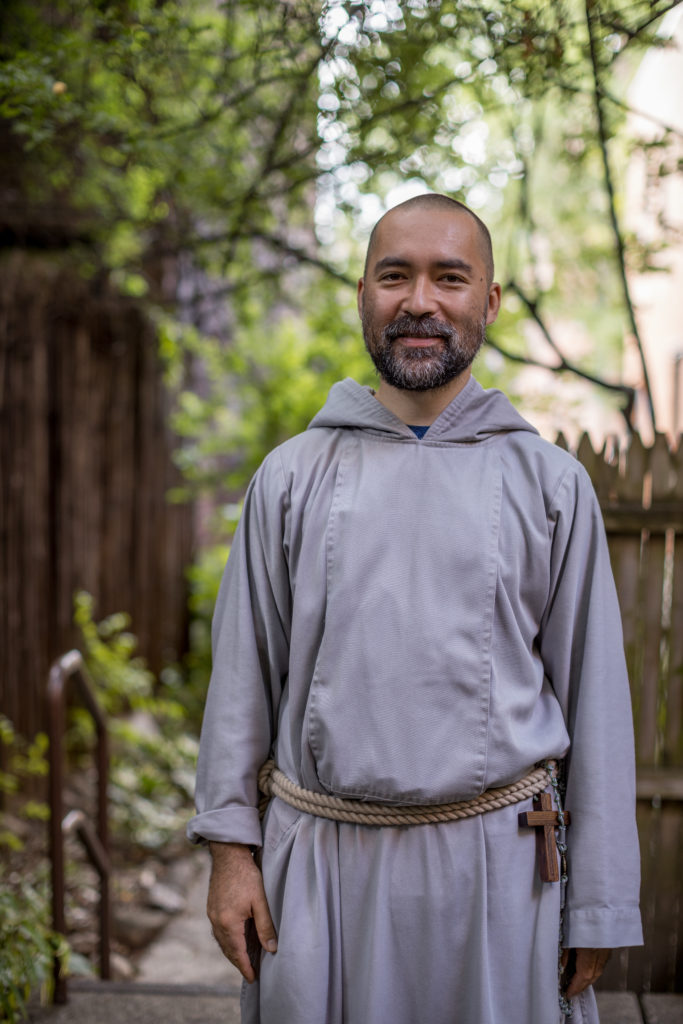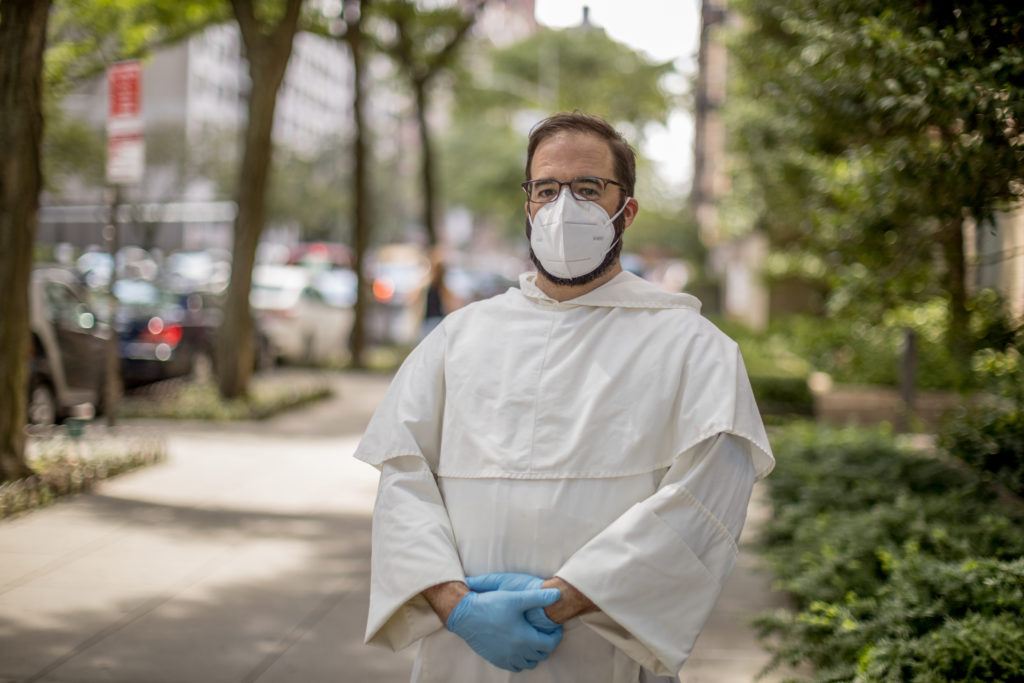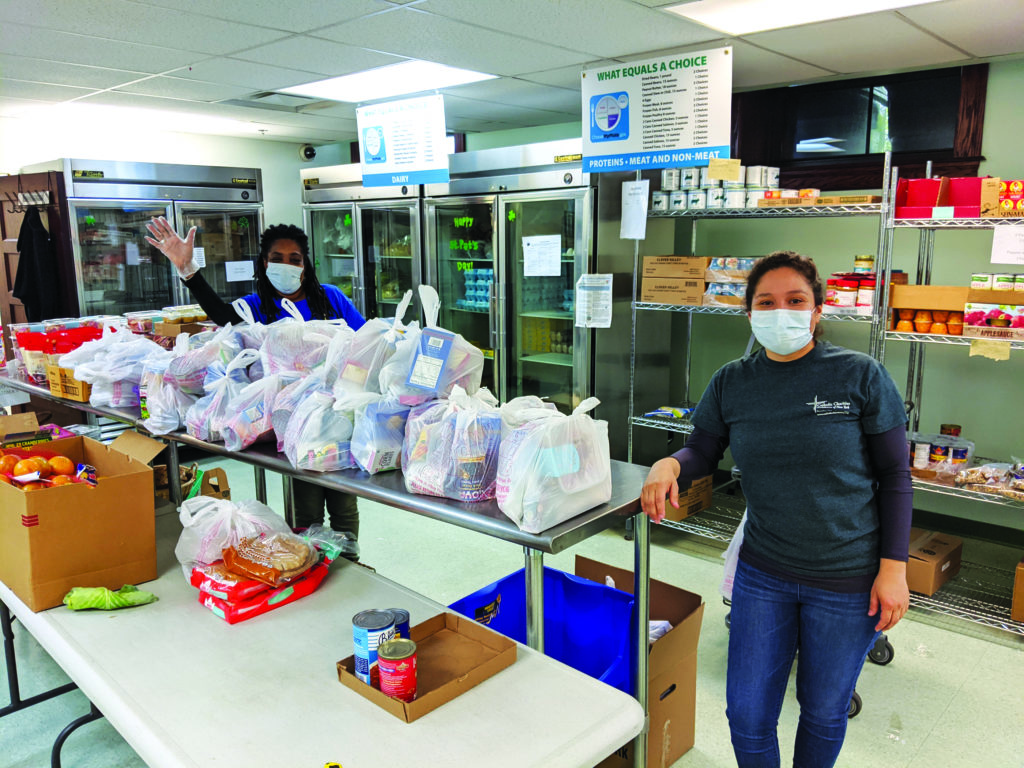On March 14, faced with mounting evidence of a growing health emergency, the Archdiocese of New York suspended public Masses in all 10 of its counties, from Staten Island to Sullivan, Ulster and Dutchess. The news took many Catholics by surprise. How were they to remain connected to their faith? How long would it be before they could safely receive the Eucharist again?
It didn’t take long for the faithful to make adjustments. Pastors, parishes and the many ministries of the archdiocese sprang into action, devising new ways to deliver the liturgy and the rituals of the Church to those who thirsted for them. And wherever there was a need, Catholics delivered services despite the obstacles.
Sr. Mary Catherine Redmond, an emergency room physician assistant who served on the front line of the pandemic in the hardest-hit part of the Bronx (see next page), summed it up this way: “It wasn’t that the Church closed. The Church just went to the streets. Whether it was people handing out sandwiches … taking care of their neighbors … [or] taking care of the sick, the Church went to the streets.”
In the next few pages, you’ll meet a number of those people – priests, sisters, friars, deacons and lay Catholics – who would not let the health crisis stop them from living out the message of Christ, sacrificing to help their neighbors at a time when the needs have only been growing more urgent. They are not looking for credit or praise; they just want to help their sisters and brothers, and they represent hundreds of others, Catholics and non-Catholics, who deserve our thanks.
HEALTH CARE
Since 1999, Sister Mary Catherine Redmond has worked as a physician assistant in the emergency department of a small city hospital in the Bronx, part of New York’s Health and Hospitals Corporation. A Presentation Sister, she resides in a Bronx convent with four other members of her congregation. This spring, when New York became the epicenter of the Covid-19 pandemic, the hospital where Sr. Mary Catherine works – like many in the region – saw a massive influx of cases.
St. Mary Catherine grew up in Kingston, where she was educated by the Presentation Sisters of the Blessed Virgin Mary at St. Mary’s/Kingston Catholic School. She entered the Sisters of the Presentation in 1987 and made final vows in 1996. “When I entered religious life, I was actually an audiologist,” she recalls. “I went back to school at the Catholic Medical Center in Queens to become a physician assistant … because I really felt called at that point to provide medical care to the underserved.”
When the Covid-19 crisis struck, she says, “It felt like a tidal wave. And as the crisis evolved, it became clearer and clearer that we were dealing with something way beyond our control.
“In the beginning, when we were working with Covid-positive patients, we were worried about where they had traveled and what contacts they had, et cetera. Then all of a sudden it was a whole slew of Uber drivers who were very sick, which meant that it was person-to-person contact. … Patients started showing up with all different symptoms, and everyone had Covid.

First we were looking for respiratory symptoms and the ground-glass opacities on the chest X-ray. The next thing, it was gastrointestinal symptoms. Then all of a sudden it was ‘I can’t smell’ and ‘I don’t taste anymore.’ They were all Covid.”
The need for personal protective equipment (PPE) was problematic in more ways than one. “We ordinarily would use PPE for going into the room of one person maybe once a week. For a staff of around 60 people now to have to use that equipment on a daily basis was just beyond the capacity of what we had. So early in the crisis, we were wearing our protective wear [which is meant to be used once and discarded] five days in a row, unless there was some sort of compromise.”
Then there was the disconnect of relating to patients from behind layers of protection. “How do you communicate with somebody, how do you reassure somebody with just your eyes? How do they know I’m smiling underneath my mask?” It wasn’t just the smile that was eliminated; it was also physical touch. “Now we had rubber gloves on, we had these gowns on. It was something we never imagined.”
Like her colleagues, Sr. Mary Catherine did the best she could for patients despite the difficulties. When her family members told her “Please be careful,” she recalls, she downplayed the risks. She worried about potentially infecting the older sisters she lived with in the convent.
And at the hospital, the number of deaths was staggering. “It was death like we’ve never seen death before. The number of body bags. The last minutes that families had with each other, which we knew were potentially the last they would ever see of their loved one. That was heart-wrenching. And when we put people on ventilators … to realize that only 20 percent of the people were ever going to make it off the ventilators was really overwhelming.”
As it turned out, some of the hardest things were also some of the largest blessings. “As part of the palliative care team,” she says, “I had some of the most deeply moving conversations with family members about the end of life, about the loss of their loved ones.”
One of the nurses suggested placing “a little story” of each patient at the bottom of the bed beside the patient chart. Then, though the intubated patients were unable to speak, the caretakers would be able to talk to them with some knowledge of their lives. “I spent an afternoon calling the families of all the patients in that unit,” Sr. Mary Catherine recalls. “I asked them questions, and they talked about their family member. That was a blessing … just listening to the families talk about their loved ones. I think they felt comforted that someone wanted to know all this information about their family member.”
Sr. Mary Catherine also felt blessed by the prayers of her congregation. “I remember once early on in religious life, one of the sisters said to me, ‘Where one of us is, we all are.’ And I would always think, every day, when I walked into the Emergency Department, We are all here.” Supportive colleagues and her own rich prayer life also helped get her through the crisis.
“I’ll always remember the names of the patients that died. It’s like a litany,” Sr. Mary Catherine says. “I still have contact with some of their families. The intensity of the time made connections that will last.”
And she adds a point of hope: “I know for sure that an awareness of the health care needs of the poor has been brought into the light. There’s been great insight into the disparity of care.”
Click here for the full Archways interview with Sr. Mary Catherine Redmond.
To read Sr. Mary Catherine’s blog posts about her experience of the Covid-19 crisis, click here.

BUSINESS NOT AS USUAL
Non-Covid medical needs did not go away in the pandemic – and some were exacerbated. In Sullivan and Ulster counties, the Catholic Charities substance abuse services were more urgently needed than ever. In the words of one dedicated rehab counselor, “Addiction doesn’t take a day off, so neither can we.” Where possible, services were delivered remotely. Right, Dr. Mike Weddel, medical director of the program, conducts a telehealth session.
BEYOND THE CALL
Dr. Helen Fernandez (left), a geriatrician and palliative care specialist at Mt. Sinai Hospital (and a parishioner at St. Francis de Sales on East 96th Street), became infected in the early days of the crisis. Sidelined as she quarantined and recovered, she secured a donation of iPads from Facebook to help patients on her ward at Mt. Sinai stay connected to family and friends who could not come to visit.

SPIRITUAL CARE

It was Good Friday when Fr. Antonio Maria Diez de Medina came to the Bronx to serve as a hospital chaplain. A Franciscan Friar of the Renewal who lives in community at St. Mary of the Assumption Friary in Newburgh, he stepped up when the community’s superior, Fr. John Paul Ourlette, CFR, asked for volunteers to help some of the many coronavirus patients facing the illness alone, without sacraments or visits from loved ones.
“When I first started at the hospital,” he recalls, “there was some apprehension about going into the Covid rooms. The doors would be closed. As a chaplain, I didn’t really have to go in – I could pray long-distance, but there’s a divide there.” To close that divide, Fr. Medina had to conquer fear. “I was a little nervous, but seeing the doctors and nurses putting on the full PPE, I followed their example. If they’re taking the risk to do that, then as a priest I decided I should do the same.”
Even inside the room, Fr. Medina found communication was not always easy when patients were on ventilators. “The ones who were conscious would look at me and not be able to speak but they could nod their head yes or no,” he says. “Others maybe had their eyes open but weren’t really responsive – and others had their eyes closed. I would just continue to speak to them and presume that they were hearing me. They couldn’t show that they heard me, but I know that they did. For somebody very ill, if I was there to do the anointing, and even just saying the words,
I think there’s grace flowing for them. … The soul is there, and even though a person’s body is not able to respond, you should treat them with dignity and love them.”
A chaplain’s first duty is to the patients, but he also serves an important function in helping families and even the health-care workers. “Part of it is to be a spiritual presence, to remind them of God’s care and love for them,” Fr. Medina says. “Sometimes there would be nurses who would come up to me and say, ‘I need a prayer.’ And I would pray with them right there and give them a priestly blessing. That’s helpful for them, to strengthen them to continue on.” In the early days of the crisis, it was especially intense. “There was that fear that was kind of crippling to people. Sometimes I had to pray with people, even the staff, against that fear that was robbing them of peace and joy.”

Despite the many challenges and the tragedy of so much suffering, there are also many blessings for the hospital chaplain. One simple one is the joy of seeing a patient get better. “There was a Covid-19 patient who had the respirator and was not responsive,” Fr. Medina recalls. “I went in and prayed with him, and the next day I came back and he was awake and talking. The nurse was really happy, she was just thanking God.”
And perhaps the greatest joy is found in the prayer itself. “Sometimes when you’re praying with people, you can see that the Lord is really touching them. Or even oneself,” he says. “Part of it, too, is just accompanying. Like when the families requested prayer for their loved one. Just accompanying them in that. That’s been a blessing as well.
“It’s been a joy I’ll always remember to be able to serve in this capacity, to be a loving witness,” Fr. Medina says. His days of chaplaincy in the Bronx are ended for now, but if there’s a second “wave” of the virus and the call goes out, he says he’ll volunteer all over again.
STEPPING UP
In early March, regional Church leaders realized that they were going to be needing more chaplains than usual in the weeks ahead. Working with ArchCare, which runs the region’s hospital chaplaincy program during normal times, the Archdiocese of New York put out a call for five additional priests from parishes and monastic communities to leave their home base and take up residence in isolation near the hospitals where they would be needed. Dozens of priests answered the call.
Among the volunteers, Fr. Antonio Maria Diez de la Medina served in the Bronx. In Dutchess County, Fr. Michael Connolly of St. Columba in Hopewell Junction and Fr. Louis Masi of St. Mary in Fishkill resided at a disused retreat house while serving hospitals and nursing homes.

A number of priests were already serving in the ArchCare chaplaincy. One of them, Fr. Hugh Vincent Dyer, OP, a friar of the Dominican health-care ministry, went into residence at the ArchCare Mary Manning Walsh nursing home. There he provided pastoral care for residents alongside the Carmelite Sisters for the Aged and Infirm, who have run the facility for decades. Via closed-circuit TV, Fr. Dyer offered daily Mass and rosary, along with occasional classic movies. He also administered sacraments to residents afflicted with Covid-19.
“The height of it all was really the month of April,” he recalls. That was when New York state was requiring nursing homes to accept coronavirus patients from area hospitals. At the Walsh home, more than 50 died. “You would suit up with gloves and masks and robes. Early on, when we were still waiting for PPE, you might be administering from the door.”
Fr. John Maria Devaney, OP, a Dominican from Fr. Dyer’s community, was working nearby at a hospital on Manhattan’s East Side. “For two and a half weeks, it was 12 hours on, 12 hours off,” he says. “ I was the overnight guy.” He recalls “going into rooms where I had to help people say good-bye via tablets. Giving the last rites while I’m holding up a tablet for the family to see because they can’t come.”
As we wait to see whether the virus has a resurgence in the region this fall, most area chaplains have gotten a well-earned break, but all are prepared to jump back in. “It’s the priest in persona Christi – in the person of Christ,” says Fr. Devaney. “It’s me, you know – the broken vessel, but nonetheless His priesthood.”
COMMUNITY CARE
When the Covid-19 crisis swept through the New York region, overwhelming medical facilities and upending the economy, those directly affected by the virus were not the only victims. As Msgr. Kevin Sullivan, executive director of Catholic Charities of New York, observes, “The problems that existed before the virus didn’t go away. They got worse.” For those already in need, the pandemic is a crisis on top of a crisis.

In the three months after the pandemic started, Catholic Charities distributed half a million meals in the archdiocese. Part of the Solution (POTS), an affiliated social services agency in the Bronx, tripled its volume of prepared meals from 450 to more than 1,300 per day. The food distribution schedule at the Ulster Food Pantry in Kingston, run by Catholic Charities Community Services of Orange, Sullivan and Ulster, went from two days a week to five.
Programs supporting immigrants, day laborers, the homeless and people struggling with substance abuse and mental health issues all had to respond to increased demand for services while also protecting the health of clients and staff. Nursing homes were especially hard hit when they were ordered by New York State to accept Covid-positive patients discharged from area hospitals without being provided with adequate protective equipment and resources.
Through all of this, thousands of caring staff and volunteers at hundreds of organizations kept on helping our neighbors, reaching out to clients electronically or through home visits, taking on new roles in organizations, improvising new ways to deliver help to those in need. To all of these giving souls, including the few pictured here, Archways offers a humble salute.
For more information on how services are being delivered during the crisis, see “Outside the Box.”
